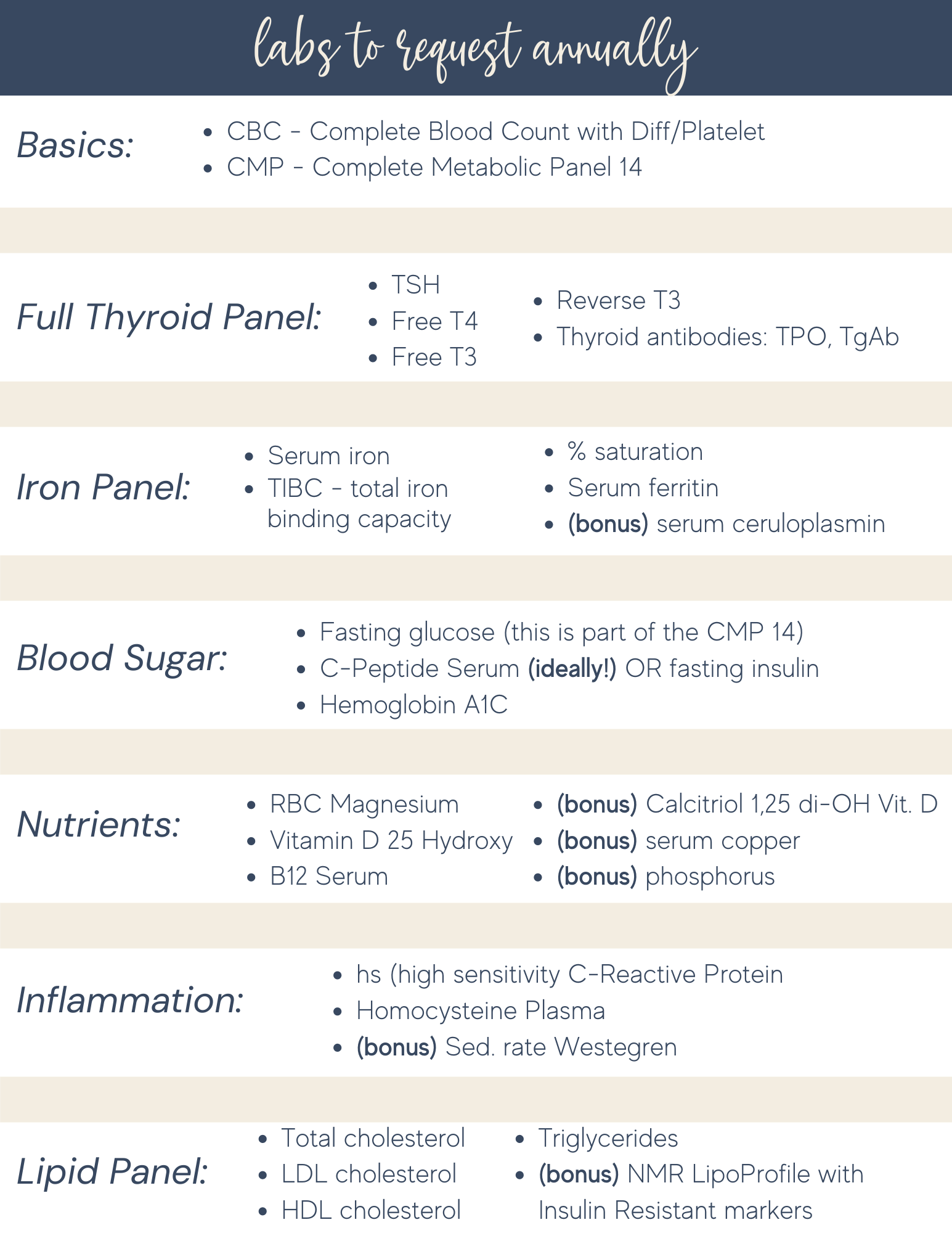As we start a new year and you may be thinking about how to improve your health, one of the best ways to objectively assess your health is through blood work testing.
I have had many clients tell me their doctor has told them all their blood work is normal and to keep doing what they’re doing. But then they come to me with physical, or even mental/emotional complaints.
This is partly because our medical system doesn’t do much by way of disease prevention. Instead, we are told our labs are fine and normal until the numbers are far enough out of range that pharmaceuticals are prescribed, which generally are for one specific problem and not addressing the host of reasons that the problem has arisen in the first place.
When we take a more careful, comprehensive look at the whole person, including these important labs, we can get a better picture of what lifestyle modifications can be made to address growing dysfunction, before it progresses.
It’s amazing what we can learn through lab testing. Blood work can tell you how your organs are doing, how your immune system is doing, how your gut is doing, how well you’re assimilating nutrients into your body, how hydrated you really are, how much underlying inflammation you might be experiencing, and how metabolically healthy you are (basically how at risk you are for heart disease, diabetes, stroke, and even neurodegenerative diseases).
This is all quite important and always has been. But this should be on the forefront of our minds these days when it is clear that being metabolically healthy is one of the best things you can do to avoid severe disease.
Having a healthy metabolism also involves having a healthy gut, immune system, and a healthy detoxification system.
So, let’s break these labs down just a teeny bit. I’m not going into every single marker here but giving an overview. To more fully understand some of them, check back here, here, here, here, and here, which dive much deeper into these labs!
The Basics:
The CBC and CMP. These are commonly run by doctors when you have a check up or annual visit, so you likely don’t need to specifically ask for them. They check on fluids, hydration (about much more than just drinking water!), and how your kidneys and liver are doing.
You do want to request that the CBC or Complete Blood Count includes the differential, which breaks down the different amounts of white blood cells. This is really helpful and necessary to get a better idea of what your immune system and therefore gut is doing. This is one of the top things I want to see in a client’s labs.
A Full Thyroid Panel
TSH measures what your pituitary gland is telling your thyroid gland. Free T4 is telling us how much unbound (aka usable) T4 hormone there is. Free T3 is telling us how much unbound (again, usable) T3 hormone there is, which is doing most of the work associated with the thyroid.
Reverse T3 is sort of like the brakes so that the body doesn’t overproduce T3. If this is elevated, that shows us that for some reason your body does NOT want to increase your metabolism.

This can seem very odd on the surface if you have other symptoms that indicate a slow metabolism. You’d think, shouldn’t my body want to increase my metabolism if it’s too slow? Ideally yes, but, there are a lot of reasons that your body would want to slow it down if there are underlying stressors! This is why weight gain/loss can be difficult and about way way waaaay more than just eating less and moving more.
Full Iron Panel
The best way to really see what your body is doing with iron and whether or not it wants more is with the % saturation and the TIBC – total iron binding capacity. This is telling us how much your cells are actually saturated with iron and whether or not they want more. Usually these numbers trend opposite of one another, so if your cells are highly saturated with iron the % saturation will be high but the body won’t want more so the TIBC (this is how much your body is trying to basically grasp more iron) will be low.
One interesting thing here, and go back to this blog to read more, is that you can have a high amount of iron in your cells but still be anemic. Often low iron gets lumped in with anemia but there are other forms and causes of anemia.
Blood Sugar:
One that your doctor probably doesn’t typically run is the C-Peptide serum. This is similar to fasting insulin (which is DIFFERENT than fasting glucose) but is actually a better indicator of your body’s blood sugar response system. It is released basically 1:1 with insulin but lasts longer in the body so you can basically see what insulin is doing better from a marker that isn’t insulin than insulin itself. Sounds confusing and it is but like I always say, our bodies are complex!
Nutrients
When checking magnesium, you should definitely check the red blood cell (RBC) magnesium, not just serum. Most magnesium exists within the cells, so this will give a better indicator of how your levels are.
Vitamin D – the typical test for this is the 25 Hydroxy or 25 OHD. This is a huge topic itself but a better indicator of your actual vitamin D status is Calcitriol 1,25 di-OH Vit. D. This is a different marker but is the actual usable form of vitamin D in your body. You can have high 25 Hydroxy and think your levels are good but low Calcitriol. So if you can convince your doctor to run this, that’s even better! I can also run this (and all these labs) for you.
Inflammation:
Several of the other tests listed here will also give us an idea of how much inflammation you’re experiencing but these labs are more specially testing certain types of inflammation.
Lipid Panel:
The usual one your doctor will run includes the total, LDL, and HDL cholesterol as well as triglycerides. I have much to say on the topic, which again, you can read here! This standard lipid panel is a good starting point to see some risk factors but if you have any concerns about your heart health and think you are higher risk, I recommend asking for an NMR LipoProfile, also called a fractionated lipid test.
Personally, if I was told I need a statin, I would first ask for this test. But that’s just me 🙂
After Getting Tested
Now, once you have these test results, interpreting them is the next step. Read all about this here please but lab ranges are all over the place. Just because you’re in the “normal” range doesn’t necessarily mean it is optimal. There is a big difference sometimes between normal and optimal. Also, something could be pulling a blood marker up while there’s another factor at play pulling it down, making it appear normal. The only way to really know if that’s happening is to look very carefully at everything being tested and understand how they play off one another. This is where the art of blood chemistry comes in and where a practitioner trained in this such as myself, can help!
Most (not all but they can be added on) of these labs are included in my Happy Belly and Metabolic Reboot Programs. We dive into what your body is objectively telling us. We certainly pay attention to your symptoms, because those are obviously important as well but it can be really nice to see some actual data.
And then we take that data, and formulate a plan that works to improve your gut, immune, hormone, and metabolic health!
Contact me here or schedule your free discovery call today!
